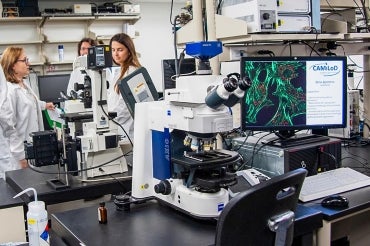U of T Faculty of Dentistry opens state-of-the-art imaging facility for researchers

Published: July 25, 2019
CAMiLoD doesn’t have horses, knights or kings, but the new state-of-the-art imaging facility at the University of Toronto could nevertheless give rise to legends of the research world.
The Collaborative Advanced Microscopy Labs of Dentistry opened its doors to the research community earlier this month with a full day symposium and workshop at the Faculty of Dentistry.
“We wanted to collectively pool our equipment and make it useable for the entire community,” says Boris Hinz, a professor in the Faculty of Dentistry with a cross appointment at the Institute of Biomaterials and Biomedical Engineering, who spearheaded the project.
Housed in the faculty’s newly renovated research laboratories, CAMiLoD is where investigators of all stripes can rent time on some of the world’s best microscopy equipment to further their research. The available equipment includes: specialized, upright confocal microscopes with water-dipping lenses; epiflourescence microscopes with fully automated motorized stage and on-stage incubation and a Zeiss LSM 880 Airyscan, which allows users to see their samples in 4D at high speed and sub-diffraction resolution.
“With CAMiLoD, faculty, students and industry partners can come to the faculty from all over the world to further their research, laying the ground for scientific and clinical collaborations, innovations and breakthroughs,” Daniel Haas, the dean of the Faculty of Dentistry, said at the symposium earlier this month.
The facility will offer users more than just imaging. Embedded within its existing services – light, force, and electron microscopy, as well as histology and image data analysis – CAMiLoD plans to offer those working with hard-to-transport samples the option of using shared cell culture and flow cytometry labs.
To accommodate the service, CAMiLoD hired imaging analyst Joao Firmino, who will assist facility users with image post-processing and quantitative analysis.
“Pretty pictures are great, but not enough,” says Firmino. “You need objective, quantitative data to get into the high-impact journals. We are here to help with this.”
“We hope this fully integrated approach – offering both cell culture and imaging – will be an asset to our research partners and students everywhere,” adds Hinz.
“Our team, which is co-ordinated by CAMiLoD manager Dhaarmini Rajshankar, has the technological and biological expertise to address your scientific problems.”



